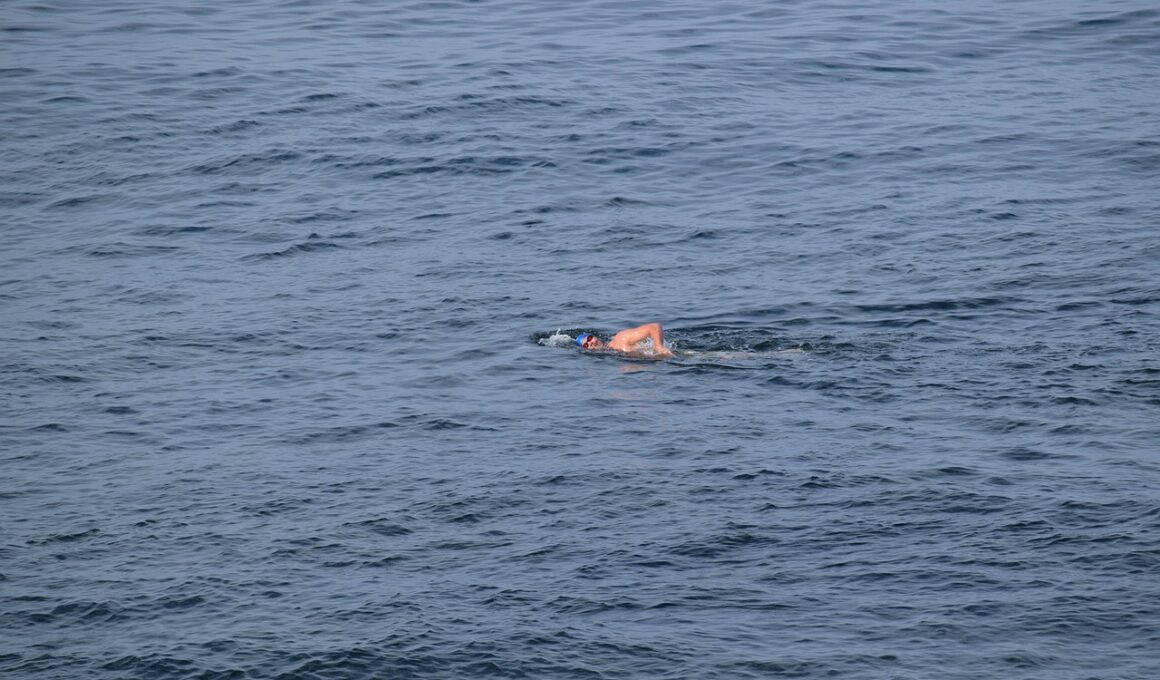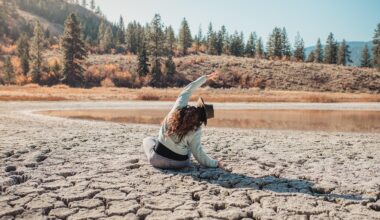How to Handle Cramping and Fatigue During Open Water Swims
Open water swimming can be a demanding but fulfilling activity. Athletes often encounter muscle cramps and fatigue during long swims, which can significantly impact performance and enjoyment. Understanding the causes of cramping is essential for prevention. Factors such as dehydration, electrolyte imbalance, and fatigue contribute to cramping. Swimmers should maintain adequate hydration before and during their swim, consuming water combined with electrolytes. Foods like bananas and nuts can help. Additionally, stretching and warming up can prepare muscles for action. Swimmers should consider taking shorter intervals and paddling techniques to reduce fatigue and manage energy levels effectively. Mixing in occasional rest periods can be beneficial. Another important strategy is to practice breathing techniques during swims, which can supply adequate oxygen to muscles. Proper body position and stroke techniques are also critical, as they allow for more efficient swimming and lessen physical stress. Remember, keeping an eye on your body’s signals is vital. Regularly adjusting your pace and maintaining a steady rhythm will help you remain comfortable and focused. By implementing these strategies, swimmers can reduce cramping incidents and enjoy the wonders of open water swimming.
Recognizing Signs of Fatigue
Learning to recognize the early signs of fatigue can significantly enhance safety during open water swims. Swimmers should pay attention to both physical and mental cues that indicate a need for rest. Physical signs include muscle stiffness, decreased stroke efficiency, and difficulty maintaining form. Swimmers might also experience shortness of breath or a noticeable increase in heart rate. Mentally, feelings of discouragement or a lack of focus can signal that it’s time to take a break. When experiencing fatigue, it’s vital to listen to your body. For instance, knowing when to switch from competitive strokes to a leisurely backstroke can help conserve energy. Furthermore, establishing a connection with fellow swimmers can provide both motivation and safety during long swims. Swimmers are encouraged to use sighting techniques to keep track of their surroundings and avoid disorientation, which can worsen fatigue. Staying aware of your environment ensures you can pace yourself according to conditions. Overall, recognizing these signs early can prevent intense fatigue and cramping, allowing for a more enjoyable and safe experience when swimming in open water.
Nutrition plays a critical role in preventing cramping and managing fatigue during open water swims. Swimmers need to fuel their bodies with the right balance of nutrients before and after their swimming sessions. A well-rounded diet, rich in carbohydrates, proteins, and healthy fats, will support energy levels and muscle recovery. Incorporating foods high in magnesium, potassium, and calcium can help maintain electrolyte balance. Foods such as leafy greens, nuts, dairy products, and bananas are excellent choices. Additionally, thinking about meal timing is essential; swimmers should eat a substantial meal at least two to three hours before swimming. Between swims, consuming energy bars or hydration drinks equipped with electrolytes can boost stamina. However, every individual’s nutritional needs can vary; experimenting with different foods and hydration tactics will help swimmers discover what works best for them. Keeping a food diary can assist in tracking how dietary options affect performance. By paying attention to nutrition and hydration, swimmers can reduce the risk of excessive fatigue and muscle cramps while maximizing their overall swimming experience.
Techniques for Reducing Cramping
Implementing specific techniques can significantly reduce the chance of cramping during open water swims. One effective strategy is to warm up properly before every swim; gently swimming or stretching beforehand prepares muscles for exertion. This practice should include dynamic stretches that prioritize the targeted muscles used while swimming. Additionally, practicing proper hydration before entry into the water keeps the body functioning optimally. Swimmers should consider adjusting their stroke technique, ensuring that movements are smooth and efficient, which can reduce pressure on muscles. Learning to relax during swimming plays a crucial role in preventing cramps. Swimmers should focus on exhaling and being aware of their breathing rhythm, maintaining a good oxygen supply to buoy energy levels. Interval training can also be beneficial; it alternates between high-intensity sprints and recovery periods, allowing muscles to rebuild and recover energy. Finally, consider practicing in open water conditions before events to adapt to the environment and identify optimal techniques. Employing these strategies can greatly decrease the likelihood of cramping, adding to a more enjoyable swimming experience overall.
Sometimes, muscle cramps can occur even when you take precautions. Knowing how to manage these cramps effectively is critical to maintaining safety in open water swimming. First and foremost, it’s essential to remain calm. Panicking can lead to erratic movements that worsen the situation. Upon feeling a cramp, try to float on your back or switch to a gentle kicking motion. Floating allows your body to relax while the cramp subsides. Stretching the affected muscle can provide relief as well; for instance, if your calf is cramping, gently pulling your toes toward you can ease tension. Massage can also alleviate pain and can be done even in the water. If the muscle fully relaxes but still feels fatigued, consider resting and waiting for a few moments before resuming your swim. Identifying the specific movements that may have led to cramps can help adjust your swimming technique in the future. Always ensure help is nearby in case conditions prove unsafe. By having a solid cramp management plan, swimmers can become more confident navigating the unpredictable nature of open water swimming.
Long-Term Strategies for Prevention
Adopting long-term strategies for both muscle cramping and fatigue is essential for regular open water swimming. Consistently including swimming drills and core strengthening exercises in your workout routine helps enhance muscular endurance. Building overall fitness will naturally improve the body’s ability to withstand prolonged physical exertion. Additionally, regular yoga or flexibility training sessions can enhance mobility and muscle relaxation. This type of exercise directly reduces the risk of cramping caused by overexertion. Following a structured training plan allows swimmers to build stamina gradually, ensuring appropriate conditioning leading into marathon swims. Another critical aspect involves proper gear selection, such as wetsuits or swim fins, that allow for efficient swimming without unnecessary strain on muscles. Swimmers can also benefit from joining local swimming clubs to practice collaboratively, fostering a community that encourages sharing wisdom on preventing cramping and fatigue. Establishing valuable connections can lead to mentorship opportunities and motivation for those new to open water swimming. All these long-term strategies collectively contribute to the growth of a swimmer’s resilience and enjoyment, making every open water swim a rewarding experience.
In summary, mastering techniques for handling cramping and fatigue during open water swims is crucial for a successful swimming experience. Swimmers must recognize signs of fatigue, optimize nutrition, and employ effective techniques for prevention. Staying adequately hydrated and being mindful of nutrition helps maintain performance levels. It’s essential to understand and implement stretches, warm-ups, and recovery techniques to minimize muscle cramps. When cramps unexpectedly occur, knowing how to manage them quickly will maintain safety. Utilizing the community and seeking advice provides beneficial resources. Long-term strategies ensure continued improvement in swimming performance, facilitating the development of endurance and decreasing incidents of cramping. By combining practical knowledge with regular practice, swimmers can enhance their open water experiences. With these teachings embraced and applied, swimmers pave the way toward enjoyable and fulfilling adventures in open waters. The thrill of conquering challenges and immersing oneself in nature will bring joy and satisfaction. Embracing the water is empowering, allowing individuals to unlock new heights within their swimming journey. As such, it is crucial always to be prepared, informed, and resilient in the face of obstacles while swimming.


